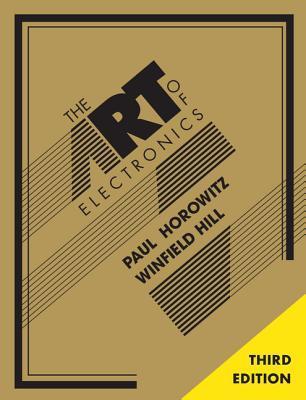the best books for developers

Topics: Hardware Design, Electronics
By Paul Horowitz, Winfield Hill
9780521809269
"The Art of Electronics" by Paul Horowitz and Winfield Hill is like the electrician's Bible. This book takes you on a journey through the wonderful world of electronics, from the basics of voltage and current to the complexities of microcontrollers and integrated circuits.
First, it starts with the fundamentals – Ohm's Law, Kirchhoff's Laws, and all that jazz. You'll learn how to handle resistors, capacitors, and inductors like a pro, and build circuits that do cool stuff like amplifying signals and filtering out noise.
Transistors are like the rock stars of electronics, and this book shows you how to use them for amplification and switching. You'll discover the magic of diodes, and how they make things like LEDs and solar panels work.
Then, it's all about analog electronics – creating and manipulating continuous signals. You'll dive into op-amps (operational amplifiers) and see how they can be the heart of countless circuits, from audio amplifiers to signal filters.
Digital electronics takes center stage with logic gates and flip-flops. You'll learn how to build binary adders, counters, and even your own digital clock.
Microcontrollers are the brains of modern electronics, and this book introduces you to them. You'll see how to program them and create projects like digital thermometers and infrared remote controls.
But wait, there's more! The book covers analog-to-digital and digital-to-analog conversion, which is like the bridge between the analog and digital worlds. You'll also delve into sensors and how they interact with microcontrollers to measure everything from temperature to light.
Finally, the book explores power supplies and voltage regulation – essential for keeping your circuits happy and safe.
Throughout the journey, you'll not only learn the theory but also get hands-on with practical projects and experiments. Whether you're a beginner or a seasoned electronics enthusiast, "The Art of Electronics" is like your trusted guide to mastering the art and science of building electronic circuits. It's like having a super-smart mentor who shows you the ropes and helps you become a true electronics wizard.
Chapter 1: Foundations
In the opening chapter, the book lays the groundwork for understanding electronics. It introduces basic concepts like voltage, current, resistance, and power, setting the stage for more advanced topics. The chapter covers essential tools and equipment for working with electronics.
Chapter 2: Diodes and Applications
Chapter 2 delves into the world of diodes, semiconductor devices that allow current to flow in one direction. Readers learn about diode characteristics, rectification, and applications in circuits like power supplies and voltage regulation.
Chapter 3: Amplifiers: Small Signals
This chapter explores small-signal amplifiers, starting with basic transistor principles. It covers amplifier configurations, gain, frequency response, and introduces the concept of transconductance amplifiers. Readers gain insights into designing and analyzing amplifiers for various applications.
Chapter 4: Transistor Switching and Amplifying
Chapter 4 continues the exploration of transistors, focusing on their switching and amplification capabilities. The chapter covers common-emitter amplifiers, transistor switching circuits, and power amplifiers. It provides practical guidance on designing and optimizing transistor-based circuits.
Chapter 5: Field-Effect Transistors (FETs)
In this chapter, the authors introduce field-effect transistors (FETs) and their characteristics. Readers learn about FET amplifiers, biasing, and practical applications. The chapter also explores operational amplifiers (op-amps) and their role in electronics.
Chapter 6: Operational Amplifiers as Amplifiers
Chapter 6 delves deeper into operational amplifiers (op-amps) and their use as amplifiers. It covers op-amp configurations, feedback, and stability. Readers gain a comprehensive understanding of op-amp behavior and applications.
Chapter 7: Voltage Amplifiers
This chapter focuses on voltage amplifiers, both discrete and integrated. It explores voltage amplifier design and performance analysis, offering practical insights into creating high-quality amplification circuits.
Chapter 8: Precision Circuits
Chapter 8 dives into precision circuits and the challenges of achieving accuracy in electronic systems. Readers learn about topics like voltage references, voltage regulation, and analog-to-digital conversion (ADC). The chapter emphasizes the importance of precision in electronic design.
Chapter 9: Filters and Signal Processing
Filters and signal processing take center stage in this chapter. The authors cover filter types, frequency response, and design techniques. Readers gain expertise in crafting filters for applications such as audio processing and signal conditioning.
Chapter 10: Oscillators
Chapter 10 explores oscillators, circuits that generate periodic waveforms. It introduces different oscillator types, including RC oscillators, crystal oscillators, and voltage-controlled oscillators (VCOs). The chapter provides guidance on designing stable and reliable oscillator circuits.
Chapter 11: Voltage Regulation and Power Conversion
This chapter delves into voltage regulation and power conversion techniques. Readers learn about linear and switching regulators, as well as power amplifiers. The chapter emphasizes efficient power management and conversion in electronic systems.
Chapter 12: Digital Electronics
Chapter 12 shifts the focus to digital electronics. It covers digital logic gates, flip-flops, and binary arithmetic. Readers gain a foundation in digital circuit design, including combinatorial and sequential logic.
Chapter 13: Digital Arithmetic and Analog-to-Digital Conversion
The authors explore digital arithmetic and analog-to-digital conversion (ADC) in this chapter. Readers learn about binary representation, arithmetic operations, and ADC principles. The chapter bridges the gap between analog and digital worlds.
Chapter 14: Microcomputers
Chapter 14 introduces microcomputers, the brains of modern electronics. It covers microcontroller architecture, programming, and practical applications. Readers discover how to interface microcontrollers with sensors and other components.
Chapter 15: Microcomputers, Practical Circuits
This chapter offers practical examples of microcontroller-based circuits. Readers explore projects like temperature measurement, digital control, and data logging using microcontrollers. The chapter emphasizes hands-on experimentation and project implementation.
Chapter 16: Filters and Oscillators Revisited
Chapter 16 revisits filters and oscillators with a focus on practical applications. Readers gain insights into designing and building filters and oscillators for specific purposes, including audio processing and communication.
Chapter 17: Low-Power Design
The book concludes with a chapter on low-power design, a critical consideration in modern electronics. It explores techniques for minimizing power consumption in electronic systems, extending battery life, and optimizing energy efficiency.